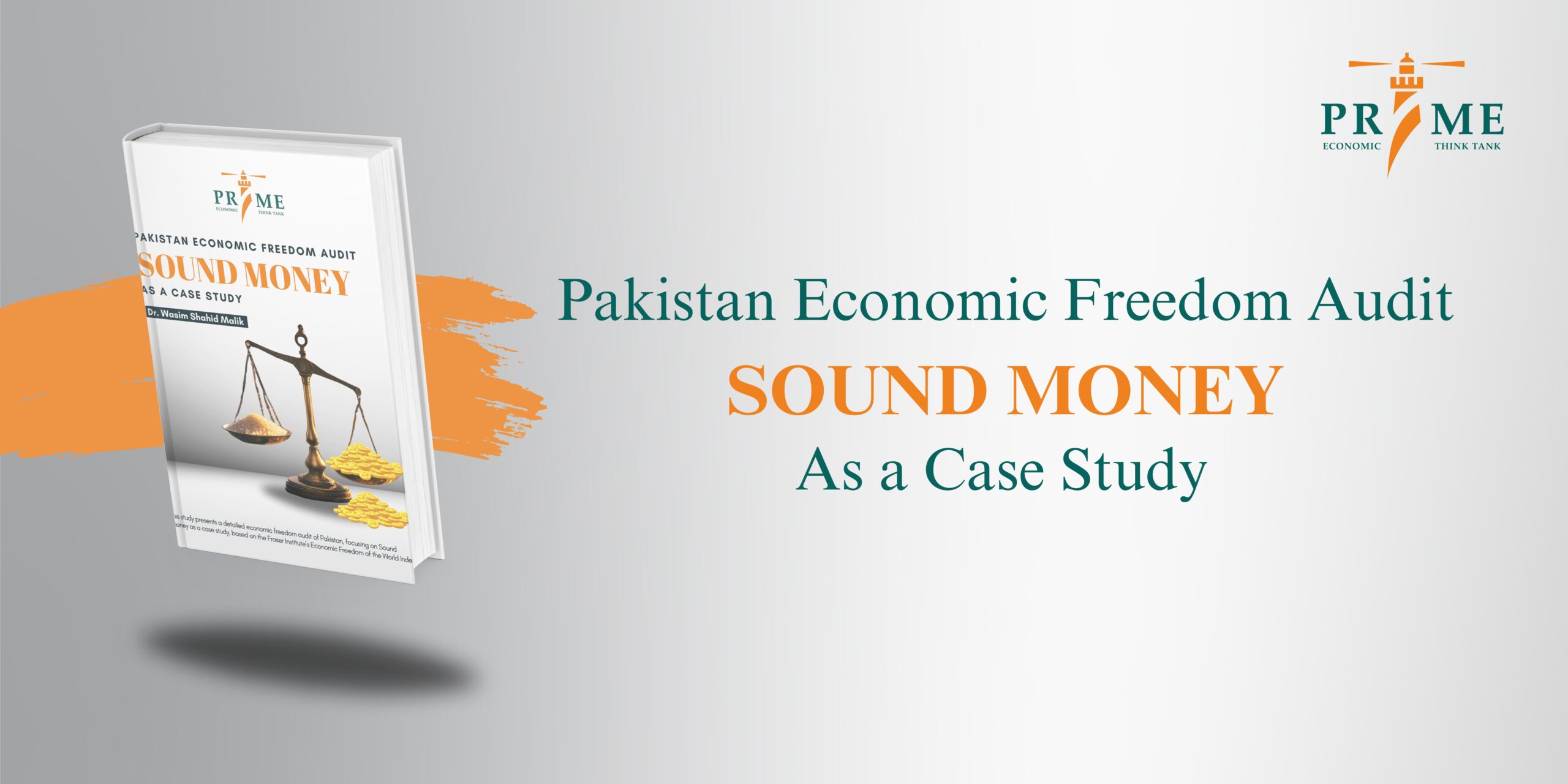
This study presents an economic freedom audit of Pakistan, focusing on sound money
as a case study. The success of free market capitalism is contingent upon protecting
individual property rights. The Fraser Institute’s Annual Report on Economic Freedom
of the World assesses countries based on their economic freedom index, which
comprises five areas, including sound money. This economic freedom audit report
aims to evaluate Pakistan’s monetary stability and analyze the macroeconomic
policies that have shaped its current state. Furthermore, the report critically evaluates
the methodology of the sound money sub-index to determine its efficacy in
measuring economic freedom.
Pakistan’s rating for monetary stability has been consistently low for the past two
decades and has further declined in 2023. Historically, Pakistan has had a sound
money rating of less than seven due to restrictions on residents having foreign
currency accounts and monetary expansion exceeding real GDP growth. Fluctuations
in the sound money rating were driven by recent inflation, its volatility, and monetary
growth in the near past, as the score on foreign currency accounts remained stable.
Pakistan’s historical data reveals that sound money rating has typically risen during
economic recessions caused by demand contraction but has fallen during periods of
cost-push inflation. Recent assessments reveal that Pakistan’s sound money rating for
2023 is 4.60, which is the lowest in history, primarily due to exceptionally high inflation
during the year.
Throughout history, the fragility of money has been a persistent concern in Pakistan.
The value of money has consistently depreciated over time, with a decline in its
purchasing power for goods and services included in the CPI basket by one-tenth
from 1974 to 2001 and one-sixty-eighths from 1974 to 2023. The Pakistani rupee (PKR)
has also experienced a similar decline in value against foreign currencies. For instance,
the value of one US dollar in Pakistani rupees increased from less than 10 in 1974 to
248 in 2023, resulting in a 25-fold cumulative loss.
Monetary fragility can be attributed to excessive monetary growth. The growth rate of
broad money (M2) has consistently exceeded that of real GDP by a significant margin
and has even surpassed nominal GDP growth. Real GDP has increased ten-fold over
the past five decades, while nominal GDP has increased 644-fold. However, monetary
growth during this period exceeded 1000 times, indicating inefficiencies in both
monetary and fiscal policies that have contributed to this expansion and, ultimately,
the devaluation of money. Since its inception, the Pakistani government has heavily
relied on borrowing from the State Bank of Pakistan (SBP) to finance its budget,
leading to an unsustainable monetary expansion. Although the amended SBP Act has
limited the government’s ability to issue its debt to the SBP, monetary expansion has
continued. The SBP has provided the necessary liquidity to banks, which have, in turn,
lent it to the government.
Over the last five decades, the monetary value has been fragile and unstable, resulting
from the misguided and ineffective implementation of monetary, fiscal, and exchange
rate policies. Particularly, the short-term real interest rate has remained marginally
negative and has shown poor responsiveness to rising inflation, exacerbating the
problem. The State Bank of Pakistan has recently adopted a reactionary stance in
response to inflation and currency depreciation. However, this approach proved to be
ineffective as well. The interest rate, which serves as the SBP’s monetary policy
instrument, has yielded little success in controlling inflation and exchange rates.
Furthermore, interest rate changes hurt economic activity, particularly in large-scale
manufacturing. On the other hand, fiscal slippages emanating from increased
spending without matching revenue have led to domestic debt accumulation. At the
same time, the overvaluation of the exchange rate has caused a trade deficit,
contributing to external debt accumulation. Both of these debts are responsible for the
monetary fragility that Pakistan is currently facing.
The methodology used to rate sound money requires revision, particularly for
developing countries. The rating scheme awards countries with the highest score for
inflation and money growth components if they adhere to a zero inflation or
deflationary policy. However, these policies are not preferred by any central bank
globally; rather, they aim to maintain positive inflation. Additionally, inflation
persistence may exhibit positive or negative trends over brief periods, making the
standard deviation of five years’ inflation an inadequate indicator of the solidity of
money.
This is because the standard deviation is a measure of variation that applies equally to
both rising and declining inflation. Finally, there are limited options available for scores
related to restrictions on foreign currency accounts within the country and overseas.
For example, the State Bank of Pakistan permits foreign cu rrency bank accounts in
Pakistan but restricts the flow of some types of funds into these accounts. Moreover,
certain restrictions may sometimes hurt economic freedom, but their imposition can
lead to more stable and sound money.While different countries may have varying
degrees of restrictions, the current rating scheme fails to assign scores based on the
severity of such restrictions.
A comprehensive reform agenda is needed to improve the solidity of money in
Pakistan. The rationalization of government size, effective coordination between fiscal
and monetary policies, efficient debt management, and establishment of an enabling
environment for continuous economic growth, which provides equal opportunities to
all, are pivotal requisites. It is crucial to re-evaluate the existing monetary-fiscal policy
mix and ascertain the appropriate operating instrument for the State Bank of Pakistan
to restrict monetary expansion and exercise its autonomy. Setting the policy rate to
contain inflation while expanding the money supply as a response to government
borrowing from scheduled banks is unproductive. A suitable monetary-fiscal
coordination mechanism can be designed to overcome the high inflation and
excessive debt predicament. Fiscal policy must adhere to the Fiscal Responsibility and
Debt Limitation Act, and there is a need to put in place an accountability mechanism
for the government’s non-compliance, which can help limit the budget deficit and
financing obligations. The government’s economic intrusion must be reduced through
reforms while simultaneously rendering tax policy more efficient. An Act of Parliament
can restrict the deliberate overvaluation of the exchange rate, for which a suitable
indicator needs to be developed.
